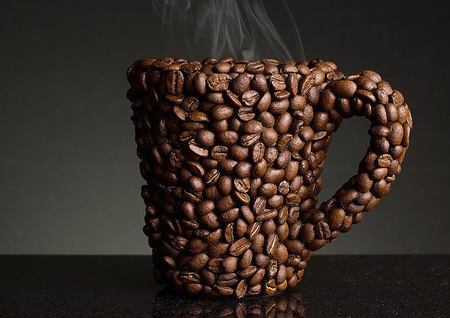
Where our beans come from.
I don’t mean ‘Jewel,’ or ‘Target,’ or ‘Starbucks,’ or ‘Peets.” I mean, do you know where your beans are traveling from? Do you know where they were grown? Where your beans are grown, combined with how they’re processed and roasted, can have a profound influence over their overall taste.
As the map above illustrates, there is really a small band of regions that actually grow coffee, consisting of countries along the equator, between the Tropic of Cancer and the Tropic of Capricorn. Before getting into the regions, let’s start with one basic concept: the difference between robusta and arabica beans.
Robusta – Coffee beans grown at an altitude of less than 3,000 ft. Typically, these will be planted and grown on flatter lands, making them easier to harvest and much more common. These beans also tend to be lower in overall quality, leading to a harsher coffee body, and higher in caffeine, leading to a more bitter flavor. Many commercial coffee brands use robusta or a robusta/arabica combination as a way of saving cost.
Arabica – These beans are grown at altitudes higher than 3,000 ft, exposing them to lower temperatures and richer, mountain soils. Due to the colder air, this particular coffee plant grows slower, but denser, producing richer, more full-bodies flavors. These crops tend to be more susceptible to parasites if not cared for properly, and must be hand-picked. Cherries on this coffee crop will only ripen once or twice a year, depending on how much rain they receive during the growing season, meaning their availability is generally lower, driving costs higher.
Coffee connoisseurs agree that arabica beans are the way to go, and most (if not all) specialty coffee chains carry only 100% arabica beans. The above map highlights the areas where arabica and robusta beans grow, and where most of our coffee comes from.
So what do each of these regions bring to the (coffee) table? Based on soil, cultivation techniques, and climate, the flavors of coffee worldwide are drastically different.
The Americas
Popular Countries – Colombia, El Salvador, Costa Rica, Guatemala
How does this region taste? – Coffee beans from the Americas tend to have a brighter, more acidic body. Lighter roasted Colombian coffees can have a tone of tangerine and walnut flavors, while Guatemalan coffee will have a hint of tart cranberries. Single origin coffees from these countries, that is to say, beans that are not blended with beans from other regions, tend to be roasted to a light-to-medium degree, preserving the acidity and sweetness.
Fun fact – The only area of North America that produces coffee beans are the Hawaiian Islands, producing the delicate (and expensive) Kona coffee, possessing trademark honey notes with a smooth, milky body.
Africa/Arabia
Popular Countries – Kenya, Rwanda, Ethiopia, Tanzania, Yemen
How does this region taste? – There can be quite a bit of variety in this region, depending on where exactly the beans are grown and how they’re roasted. Kenyan beans can have a fine, rich body, much like a high quality black tea, when roasted lightly, or it can have a deep, chocolate flavor when roasted darker. Ethiopian beans are grown and divided into four different regions, each with distinct flavors. In general, coffee from this region tends to have a crisp, berry-like essence, often with a body reminiscent of a fine red wine.
Fun Fact – The Ethiopian beans known as Harar are one of the oldest produced beans in history, and are, themselves, divided into three different categories, based on quality and flavor. Longberry is regarded as the highest quality, Shortberry beans are popular in Eastern Ethiopia and tend to be smaller in size, and Mocha will have a hint of chocolate flavors.
Pacific Rim
Popular Countries – Java, Papua New Guinea, Sumatra
How does this region taste? – Many coffee blends will use beans from this region of the world to add a touch of spice to the body. These beans tend to be full bodied with smooth, earthy flavors and a very pleasing spiced aftertaste. As a rule, coffee from this region tends to live on the medium-to-dark roast scale.
Fun Fact – While much of the history of “The Worlds Oldest Blend” is lost to…well…history, here are some tidbits on Mocha Java coffee beans. When the city of Mocha, Yemen (African/Arabian region) was a bustling port city in the 17th century, European traders smuggled coffee beans out of the country and, needing a place to grow them, planted a crop on the island of Java. Future trade expeditions to Yemen yielded coffee beans in exchange for spices which were sold with these newer “sister beans” from the island of Java. Since this time, Mocha has been replaced as a port city and relies more on a fishing economy, but the blend lives on, in some form, to this day, characterized by a smooth chocolate body, a touch of honeyed sweetness, and a hint of blueberry aftertaste.
—
So, where do you get your beans from? Ask your barista where your beans are from and begin learning what regions you prefer!


June 1st, 2013 at 9:44 pm
Great article! I learned a few new things and love the fun facts you threw in ~ so fascinating! 🙂